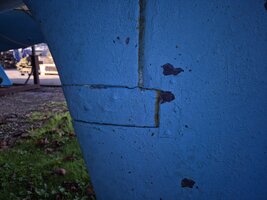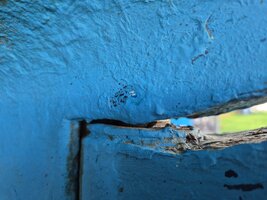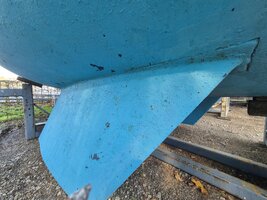Christian Mies
Temporary Member
Hi everyone!
My wife an I considered having an own boat for quite some time, but now it seems we'll do it.
We found a boat we both like very much but there are some issues on it to be taken care about.
Currently I am reading and reading through this forum and the archive an I think I will find answers to most of my questions.
But if meanwhile someone likes to point me to the right threads or has some advice, here are my points:
Rudder shoe has a some play on the skeg. As I learned it is made of cast bronze and fixed with copper rivets.
I think it will have to be completely reseated and fixed properly. Grind of heads and hammer out? Reseat with epoxy or something flexible? Fix with copper rivets again or is there something better / easier?


Antifopuling has been applied recently but on top of many old coats which flake off and are very uneven.
Am I right this sould be completely redone (scrape of and rebuild)?

A surveyor found the keel bolts too much corroded, so they should be replaced when redoing the antifouling?
Are there drawings available of where to find all keel bolts or is there even a story published of how to drop the bilge keels?
Of course there are other things, too, as leaking chainplates, old engine, ... but those things seem pretty forward for me.
Thanks a lot for any advice!
Cheers,
Christian
My wife an I considered having an own boat for quite some time, but now it seems we'll do it.
We found a boat we both like very much but there are some issues on it to be taken care about.
Currently I am reading and reading through this forum and the archive an I think I will find answers to most of my questions.
But if meanwhile someone likes to point me to the right threads or has some advice, here are my points:
Rudder shoe has a some play on the skeg. As I learned it is made of cast bronze and fixed with copper rivets.
I think it will have to be completely reseated and fixed properly. Grind of heads and hammer out? Reseat with epoxy or something flexible? Fix with copper rivets again or is there something better / easier?


Antifopuling has been applied recently but on top of many old coats which flake off and are very uneven.
Am I right this sould be completely redone (scrape of and rebuild)?

A surveyor found the keel bolts too much corroded, so they should be replaced when redoing the antifouling?
Are there drawings available of where to find all keel bolts or is there even a story published of how to drop the bilge keels?
Of course there are other things, too, as leaking chainplates, old engine, ... but those things seem pretty forward for me.
Thanks a lot for any advice!
Cheers,
Christian
